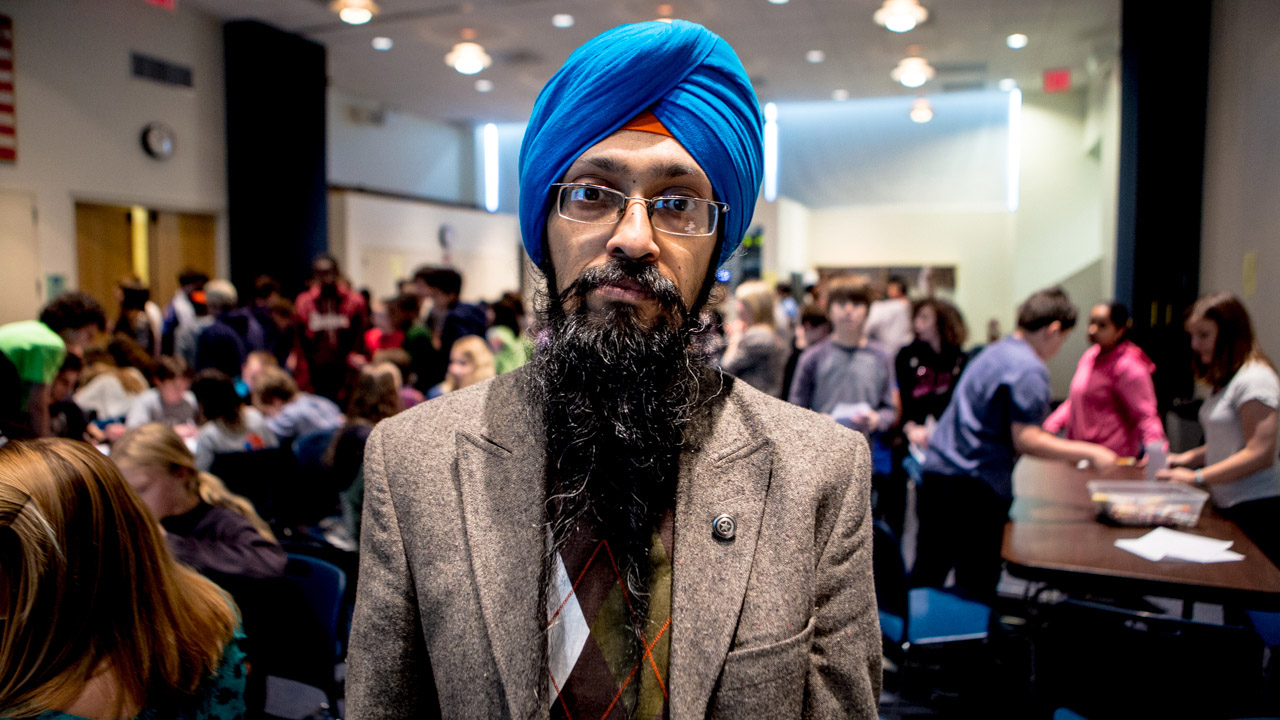With average height and a reed-thin frame, Vishavjit Singh is not an imposing presence, let alone a heroic one. But over the past few years, he has turned into a superhero for the South Asian community. Singh, a New Yorker who follows the Sikh faith, is America’s first turbaned Captain America.
“I see things in turbans and beards,” he says to an auditorium full of middle school students at Manhattan’s Churchill School, an independent K-12 school for children with special needs. Donning a blazer, green loafers and a bright blue turban, Singh is one of the a handful of speakers invited to the school for its annual Diversity Day, a more than 10-year tradition that aims to combat stereotypes and foster understanding among its student body. His commitments as a superhero and cartoonist have grown considerably since January, when the Southern Poverty Law Center’s Teaching Tolerance profiled his work.
That’s how Paula Zamora, the Churchill School’s Elementary Librarian and Diversity Initiative Co-Coordinator, found Singh. “As a librarian, Vishavjit’s work really resonated with me because I know our students are passionate about graphic novels. I’m particularly sensitive to the lack of heroines, but the photograph of Vishavjit in the Captain America costume captured the absence of diversity in superhero culture across the board in such a powerful way,” she said at the event in early May.
 Singh’s Captain America costume
Singh’s Captain America costume
New York City’s public schools are the most racially segregated in the country. And, according to the New York Times, the city’s private schools are “almost all white and mostly moneyed.” The Churchill School has three committees devoted to diversity, yet, race isn’t something the admissions applications process considers, according to Zamora, and the school doesn’t keep any statistics on the race of its faculty members. “Our school is roughly 20% students of color,” Zamora said.
This is not a problem that Singh (or Zamora) can solve on their own, but in the spirit of racial awareness, Singh now has similar talks planned in New York City schools and beyond. He conducts workshops with children and, after a presentation, they draw their own superhero cartoons. He’s found that, from Manhattan and even to Mississippi, most people are receptive (though certainly surprised, at first) when confronted by a bearded, turbaned Captain America. But even the bigots apologize when he retorts: “You’re saying mean things to Captain America.”
In college, Singh attempted to become “invisible” to society by shaving his beard and nixing the turban. He later rejoined the Sikh faith by way of Buddhism, but again ran into trouble after 9/11. In the wake of 9/11, he found inspiration after a cartoonist draw an inspirational character “to look like me.” From there, his series Sikhtoons was born.
 Singh’s illustrated biography
Singh’s illustrated biography
“That’s the beauty of cartoons, you can do anything you want to do,” he said to the impressively attentive group of teens. “With cartoons you can actually express your feelings and your history.” After a massacre at a Sikh temple in Milkwaukee, he called for a superhero who fights intolerance. Eventually, he filled that role, wearing a Captain America get-up through Manhattan and getting the reactions of passersby. He now hopes that the NYPD will amend its uniform policy to allow for a turban and a beard. “Sikhs serve in Indian armies, British armies, I hope that one day they have a police officer with a turban and a beard,” he said.
His costume represents America’s melting pot: his red and gold shoes are “hip-hop inspired” and his belt was purchased from “a Bangladeshi vendor in Chinatown.” But, as if demonstrating how narrow our views are of what an American superhero can look like, the Captain America costume he purchased only came in large and extra-large. Singh, who is 5’9″ and 130 pounds, had to “alter it big-time.”
Just as one day is not enough to properly solve the diversity issues of the Churchill School, neither is the twenty minutes enough time to create an entire cartoon character. The audience was captive and engaged, but it’s hard to tell what lesson, if any, sticks. During the drawing session, one student says, “I’m drawing my teacher.” When asked if he thought he was heroic, the eighth grader replied with a grin, “No, he’s a villain. A super villain.”
 Cartoon by a high school student
Cartoon by a high school student
But that doesn’t make the effort futile. Amongst the chatter inevitable in a room of more than 100 pre-teens, a few took the mission to heart. One girl drew a female superhero who protects nature, because, in her estimation, there are “no superheroes who care about the Earth.” Looking through the high schoolers’s cartoons from another session, there are some more serious cartoons: One woman drew a “perfect” female body with a checklist, wondering “Am I pretty now?”; another high school student drew a flag divided between two countries, captioned, “My ongoing battle with the U.S. immigration system.”
(Photos: Aymann Ismail/ANIMALNewYork)



